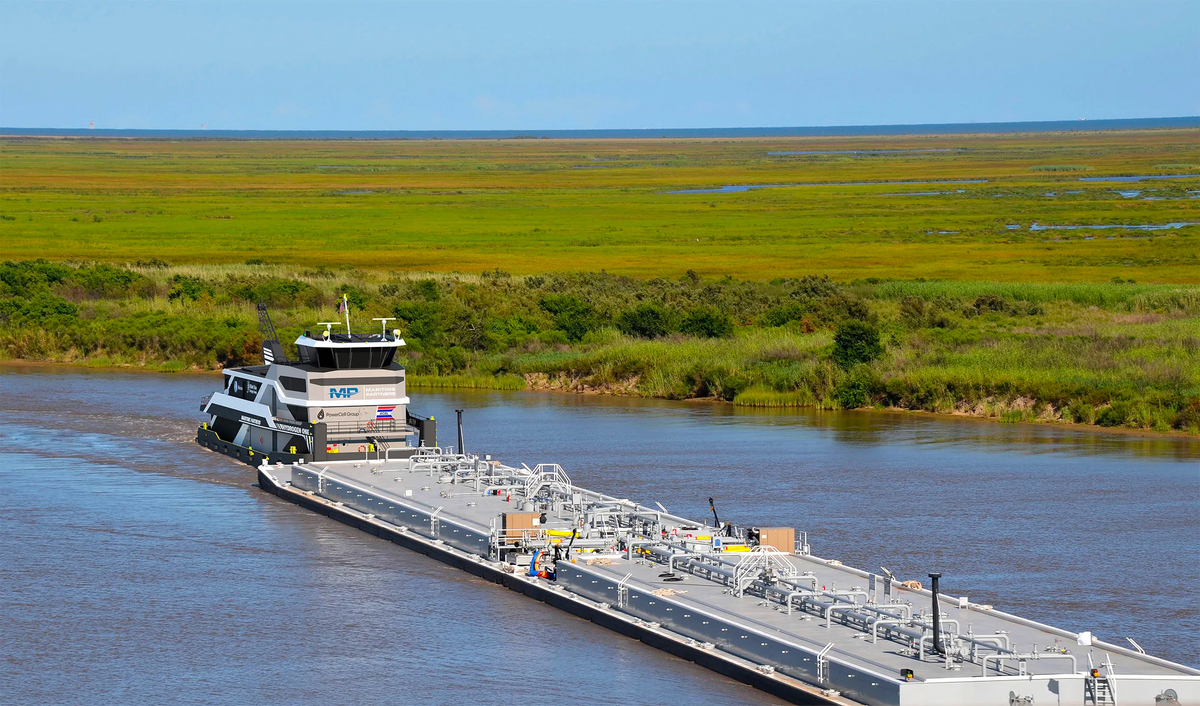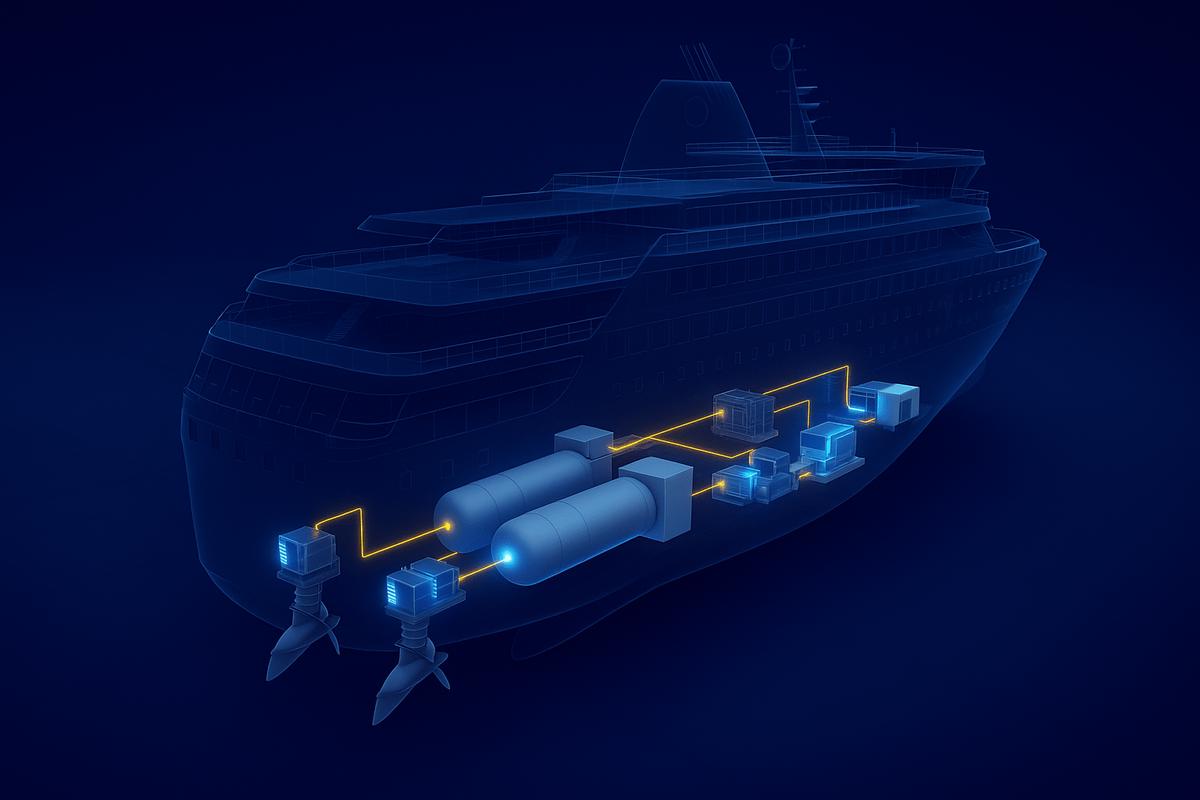Future Fuel Talks: Combustion engines won’t sideline hydrogen fuel cells – PowerCell
Swedish fuel cell maker welcomes competition with internal combustion engines as it will scale hydrogen supply chains that benefit the entire industry.
 IMAGE: The Hydrogen One, a vessel powered by a methanol-to-hydrogen fuel cell system. PowerCell
IMAGE: The Hydrogen One, a vessel powered by a methanol-to-hydrogen fuel cell system. PowerCell
Many shipping experts predict that shipping is heading towards a multi-fuel future.
But this fuel-agnostic pathway will require more than just alternative-fuel-capable marine engines, Andreas Bodén, chief technical officer at the Swedish fuel cell manufacturer PowerCell told ENGINE.
He argues that developing ammonia- and methanol-capable internal combustion engines (ICEs) will not divert funding away from hydrogen fuel cell technologies.
While ICE investments may dominate the early phase of fuel adoption, they will create infrastructure and market acceptance for fuels like ammonia and methanol, Bodén says. This can, in turn, support long-term growth of hydrogen-based technologies and keep fuel cells viable for deep-sea shipping.
Do you see investments in ammonia- and methanol-capable internal combustion engines (ICEs) diverting funding from hydrogen fuel cells, or could fuel cells play a synergistic role to complement these technologies in supporting a wider adoption of these fuels in ocean-going shipping?
Fuel cells and ammonia- or methanol-capable ICEs should not be seen as competitors but rather as complementary technologies within the maritime industry’s broader decarbonisation strategy. ICEs running on alternative fuels may attract investment and help build the infrastructure and supply chains necessary for cleaner fuels, which ultimately benefits hydrogen fuel cell adoption as well.
In reality, the industry will not follow a single-fuel pathway. Hydrogen, methanol, ammonia by themselves, or even as hybrid solutions, will all play roles depending on vessel type, route and operational requirements. In many cases, there is likely to be a combination of these technologies onboard a vessel.
For example, a large container ship could have a dual-fuel methanol ICE for its primary propulsion and use a hydrogen fuel cell generator with methanol reformer technology to power its auxiliary engines.
There is a natural synergy between methanol and fuel cells because it can be used as a hydrogen carrier. This approach [will] not only help overcome the practical challenges of using hydrogen as a fuel but, in combination with fuel cells, it can also help the industry use [currently] scarce green methanol more efficiently.
The currently available proton-exchange membrane (PEM) fuel cells are often viewed as better suited for short-sea than ocean-going shipping due to technological and storage limitations. Could this limit interest from companies with ocean-going ships and create financing challenges for scaling fuel cell adoption?
It is true that PEM fuel cells have gained more attraction in short-sea shipping; for example, we’ve seen success with RoRo vessels and passenger ferries. And we see this as a building block towards the larger ships and continue to work towards broader adoption in ocean-going vessels.
PEM fuel cells can also play a crucial role in supporting auxiliary engines on deep-sea ships, eliminating both local emissions and GHGs from those engines. These auxiliary engines are essential for manoeuvring and powering onboard systems while in port, making fuel cells a practical solution for reducing maritime emissions.
Hydrogen fuel cells can also be used for onboard operations and the recent deal with an Italian original equipment manufacturer is a good example of how this can work. One reason why we may see the continued use of fuel cells onboard ships and powering some operations is because these fuel cells also have fewer moving parts and require less maintenance than internal combustion engines.
A recent bankruptcy of a Scandinavian marine fuel cell manufacturer has raised concerns about funding and policy gaps in the EU, particularly in Scandinavia. How significant are these challenges in today’s landscape, and what kind of pressures are they placing on fuel cell manufacturers?
We recognise that support and funding for hydrogen projects vary significantly. That is why it’s important to communicate the variety of ways that fuel cells can be used today, whether this be for shore power or to run certain processes onboard vessels. We strongly believe the case can be made for the use of hydrogen fuel cells and were encouraged by the first order of our new fuel cell system from a leading European shipyard valued at SEK 150 million [$15.6 million].
The reality of global warming remains unchanged despite short-term political hesitation, and the urgency to transition to zero-emission solutions continues to grow. Delays in policy decisions do not alter the fact that there is an urgent need to transition to zero-emission solutions.
We remain firmly convinced in our belief that our solutions [will] play a vital role in the transition. In many cases, hydrogen and fuel cells represent the only viable pathway to decarbonising sectors such as maritime, aviation and other heavy-duty transport. By advancing these technologies, we can drive meaningful progress towards a cleaner, more sustainable future.
We appreciate the funding available for advanced technology development, where the outcome is uncertain but has the potential to drive innovation forward.
With that said, we are building our business on a foundation of proven technology, customer value, and real-world optimisation.
 IMAGE: Illustration of a hydrogen propulsion system on a ship with integrated liquid hydrogen tanks and fuel cells. ENGINE via ChatGPT
IMAGE: Illustration of a hydrogen propulsion system on a ship with integrated liquid hydrogen tanks and fuel cells. ENGINE via ChatGPT
How can the hydrogen fuel cell industry sustain investor confidence and build resilience amid ongoing challenges like regulatory uncertainty and funding issues?
The industry must build on the significant progress already made, which has demonstrated that hydrogen is a viable fuel solution, while also pushing the boundaries through pioneering research and development.
Steady and resilient progress is needed. PowerCell remains committed to this approach and we were pleased to report continued, stable growth at improved margin when closing 2024. With a balanced order book, we’ll be looking to continue this towards 2026.
A study by the Agency for the Cooperation of Energy Regulators (ACER) highlights risks to green hydrogen projects in the EU from uncertain demand and high production costs. Could these challenges further burden marine fuel cell manufacturers and affect the industry's long-term growth?
While demand remains uncertain, this is the nature of the multi-fuel future that the maritime industry, among other sectors, is navigating. However, companies like ours are actively exploring new and innovative technologies to address the challenges of renewable hydrogen. For example, using methanol and ammonia as hydrogen carriers can significantly enhance practicality and, in turn, costs.
Efficiency is key from the perspectives of fuel availability, cost and energy density. This is where fuel cells with reformer technology can help. They can convert methanol to energy at least 30% more efficiently than burning it in an internal combustion engine (ICE).
Onboard ships, methanol can be reformed into hydrogen, which is then used in high-efficiency fuel cells. The process involves steam reforming, where methanol reacts with water to produce hydrogen and carbon dioxide at moderate temperatures. This allows ships to generate net-zero energy without relying on pure hydrogen infrastructure, offering a practical pathway for integrating hydrogen technologies.
This process specifically applies to PEM fuel cells, which are smaller, much more efficient than other renewable and combustion-based alternatives and offer a higher power density to alternatives. For example, PEM fuel cells have 5-15% higher efficiency than methanol-based ICEs. While it may sound futuristic, PEM fuel cells with methanol reformer technology and high energy density are available today.
Historically, many technologies we now take for granted today – such as, satellites, PCs, GPS, cars, mobile phones - all started out as expensive niche products. However, with innovation, time and a good product-market fit, history has shown that these once expensive niche products can eventually evolve into mainstream, mass market solutions.
At PowerCell, we are collaborating with customers who recognise the added value of having a zero-emission product, while simultaneously working to drive innovation to expand on market opportunities. Similarly, companies developing the supply chain for green hydrogen (electrolysers, etc.) are also working towards the same goal.
How critical is a unified global regulatory framework for hydrogen adoption in shipping, and what risks do fragmented national policies pose to its growth?
Indeed, a global regulatory framework should certainly be something that the sector should strive for, but consistency across policies should be a true priority. However, we should not let great be the enemy of good, whilst an ideal scenario would be to have everyone ‘singing off the same hymn sheet’, this needs to be balanced with action through investment and infrastructure.
It is crucial to establish standards, rules and guidelines that aligns the shipping industry, shipbuilders and suppliers, particularly in areas like hydrogen and fuel cells. Organisations like the IMO and class societies play a key role in supporting the industry in this transition. Without common [global] standards, a fragmented landscape of country-specific, tailor-made policies would drive up costs and slow down progress.
We also encourage efforts to develop a standard for measuring the climate intensity of different hydrogen production pathways. This would be a key enabler of scaling up hydrogen trade across the world.
By Konica Bhatt
Please get in touch with comments or additional info to news@engine.online





